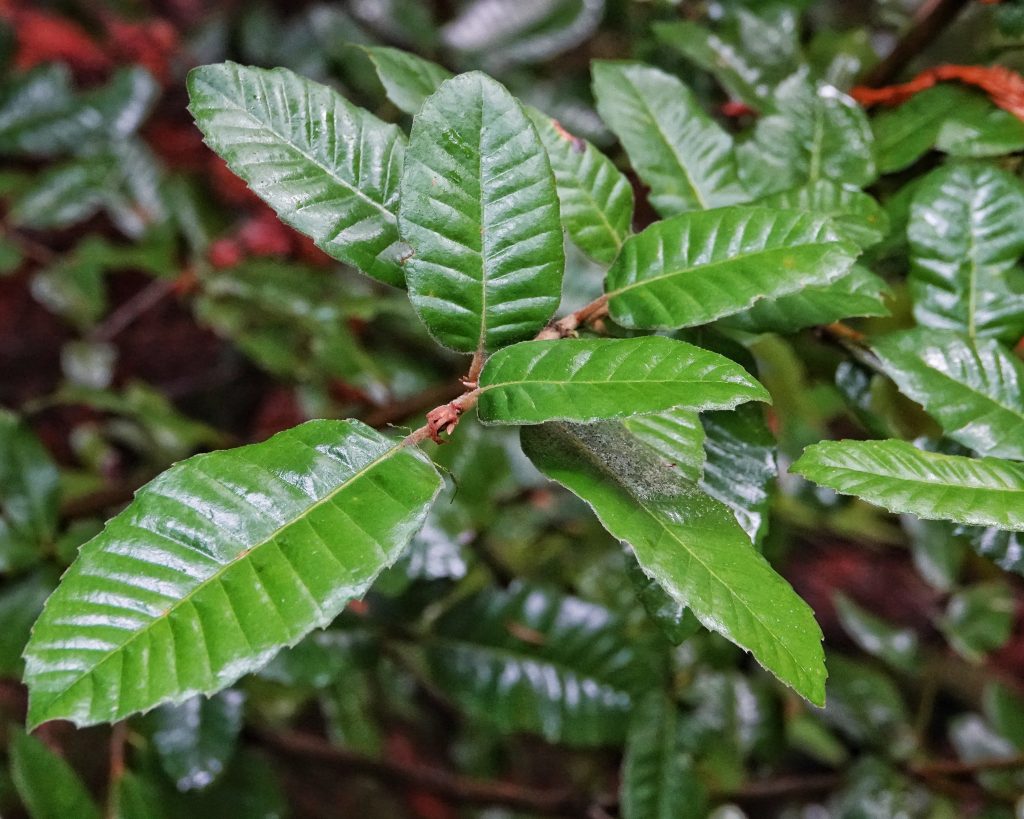
This was not a tree I was familiar with before this trip, although I had heard of it. Still, it wasn’t really on my radar, and wasn’t something I was looking for. Because I had failed to replace it in my pack after looking up Oregon myrtle the night before, I didn’t even have “Trees and Shrubs of the Pacific Northwest” (Turner/Kuhlman; 2014) with me on the Redwood Nature Trail. But I was so taken by the foliage that I tried running it through my Seek app, and actually had enough internet reception to immediately get the answer that it was tanoak, which I later verified using my field guides.
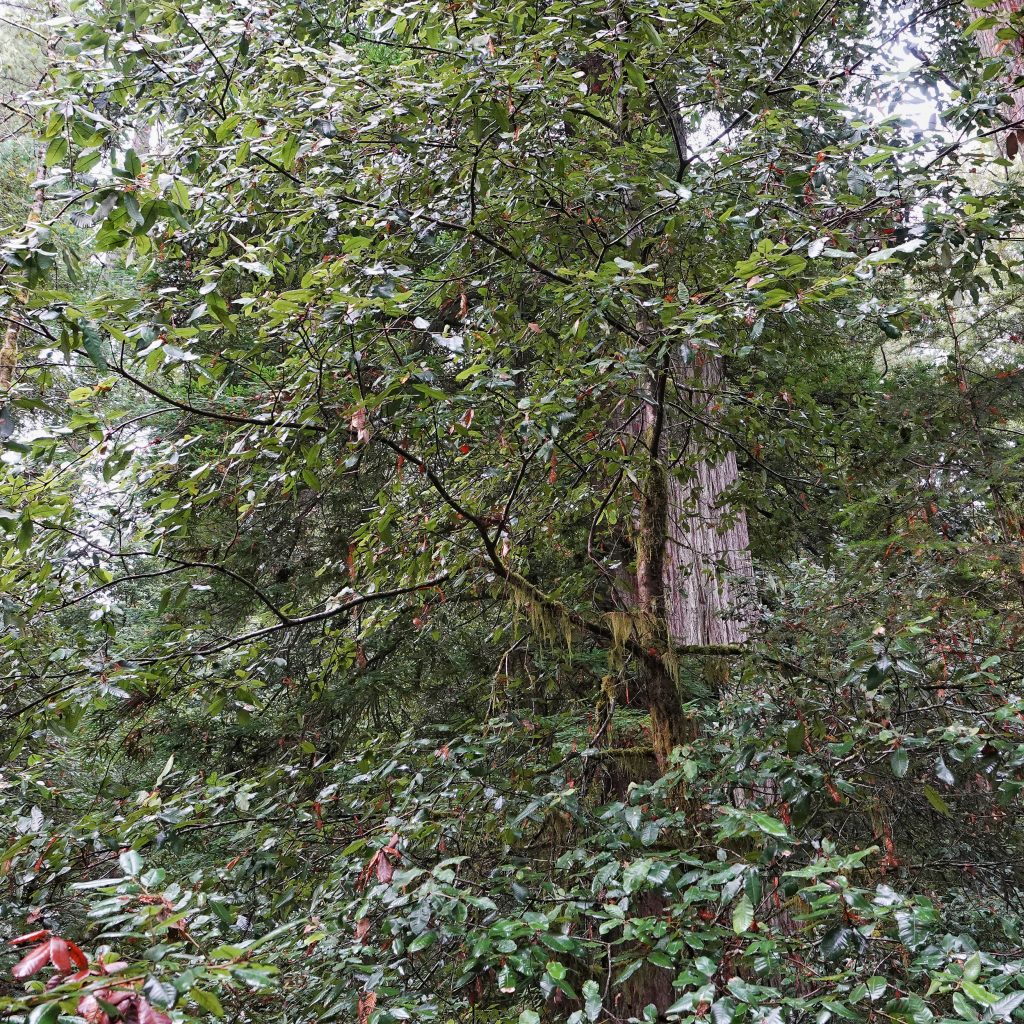
Historically this tree has been classified in the genus Lithocarpus, along with several Asian trees, and in the same clade with the chinquapins (Chrysolepis), all of which were thought to be closely related to the chestnuts because of the burs on the covering of the fruit, and other morphological similarities. But molecular evidence (Manos/Cannon/Oh; 2008) has shown that tanoak is not closely related to either Lithocarpus or Chrysolepis, but did diverge from the same lineage that led to the chestnuts, and that the similarities of fruit and flower morphology between the two clades are an example of convergent evolution. Tanoak is the only species in the genus Notholithocarpus.
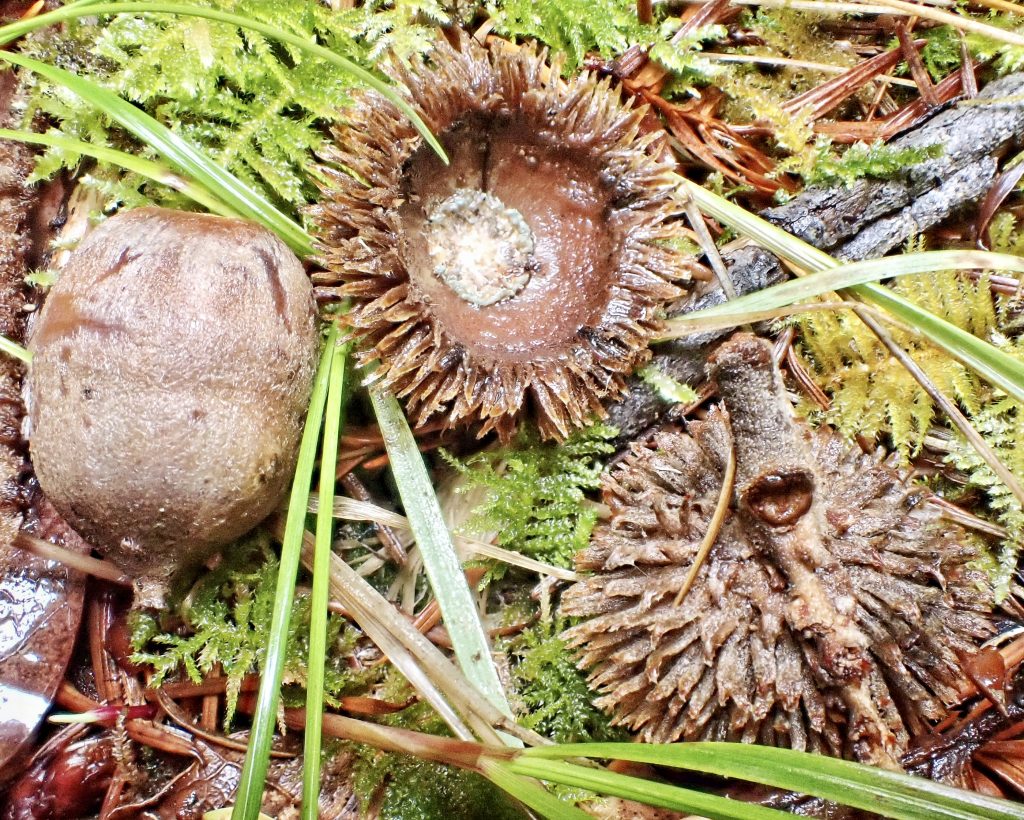
This is a very interesting tree, and integral to certain biomes. They produce abundant mast crops (up to 1,000 pounds from mature trees) in alternate years (because the acorns take two years to develop), and may produce a crop in just 5 years, although they are most productive after 30-40 years. They are shade tolerant, and are often found in the understory, but really take off when there is an opening of the canopy. Tanoak is moderately fire resistant when it is large enough to develop 3-5” thick bark, but intense ground fires and those that reach the canopy are often fatal. But it recolonizes an area fairly quickly because of acorns that may have been cached below ground by squirrels and birds, and because sprouts may issue from burls along the roots. For a more complete look at their ecology see Fryer; 2008.
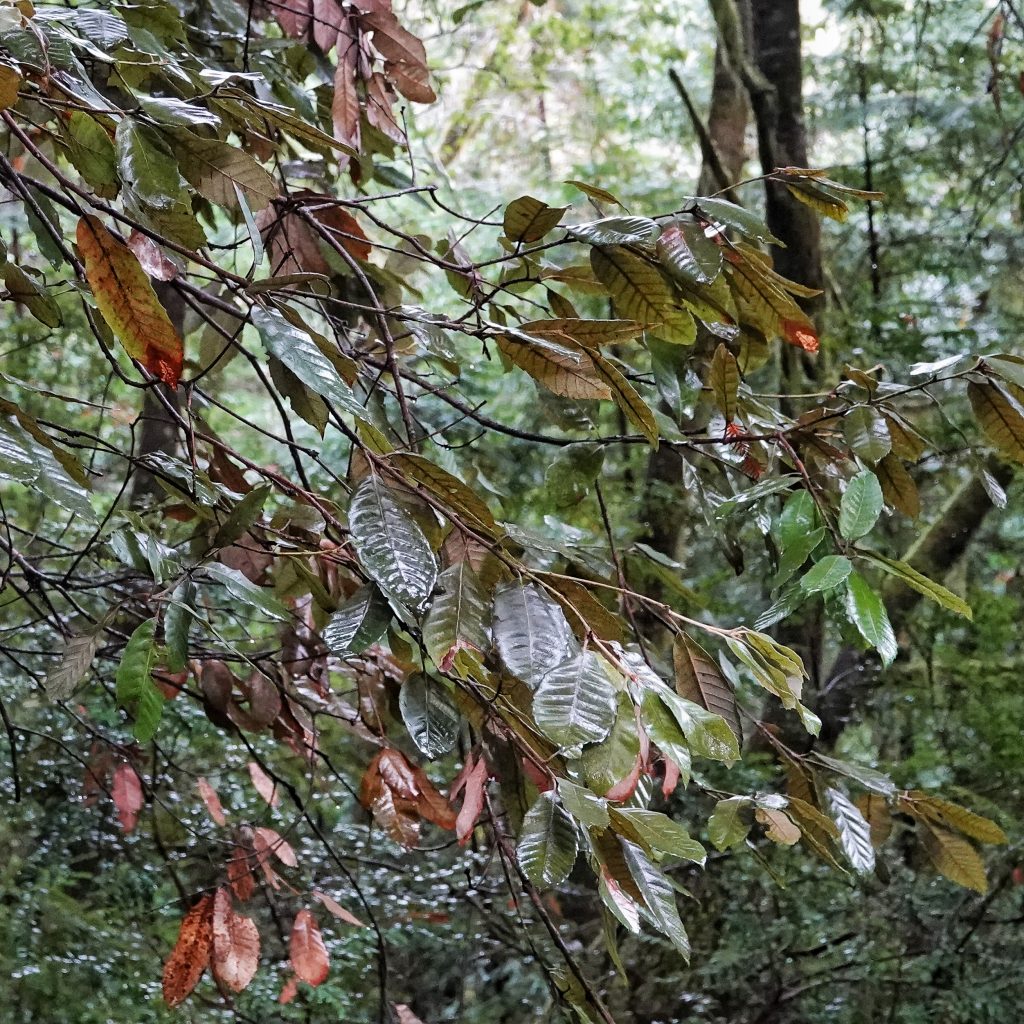
Tanoak is not particularly important for commercial harvesting, mostly being used for pulp and firewood, though it does have applications in woodworking. The bark has been used widely in the tanning industry, though it is not as popular as that of oak or chestnut. However, due to the presence of gallic and acetic acid, it does provide the best tannage for heavy leathers like those for saddles and shoe soles, and it plumps rather than shrinks the leather it is used upon.
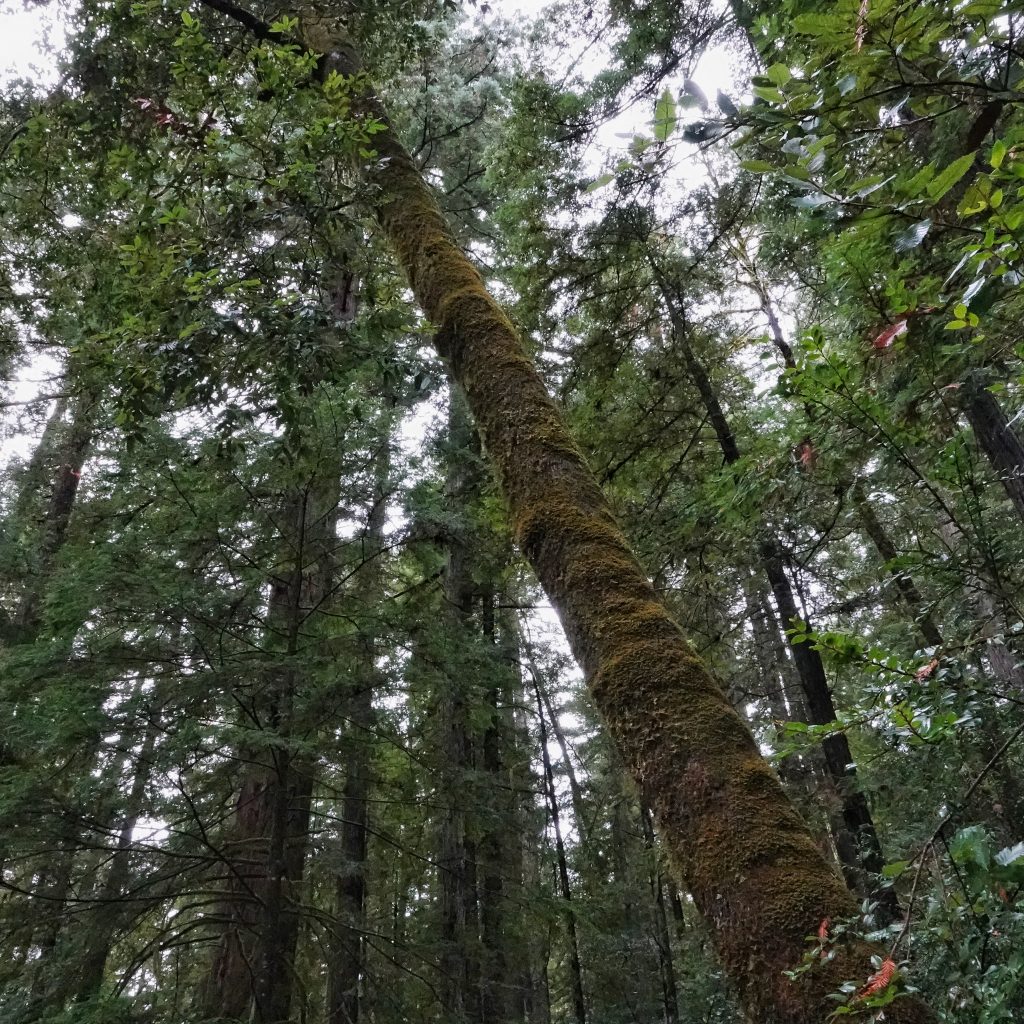
It was hugely important for the indigenous peoples of the region. For many coastal cultures acorns and salmon were a staple of their diet, and in many areas the bulk of those acorns came from tanoak, which have a higher fat content than those of Quercus spp., and were therefore preferred. Because of the high levels of tannin the acorns must be leached before eating, and there are a variety of ways to do that, as outlined by Nielsen/Alexander; 2013. After leaching they were sometimes roasted and eaten whole, but usually after drying or roasting they were ground into meal or flour, and used as porridge, mush, in soup, or baked into cakes and bread. A decoction of the bark was used as a face wash, an astringent, and to soothe coughs, and the bark was also used to make a brown dye.
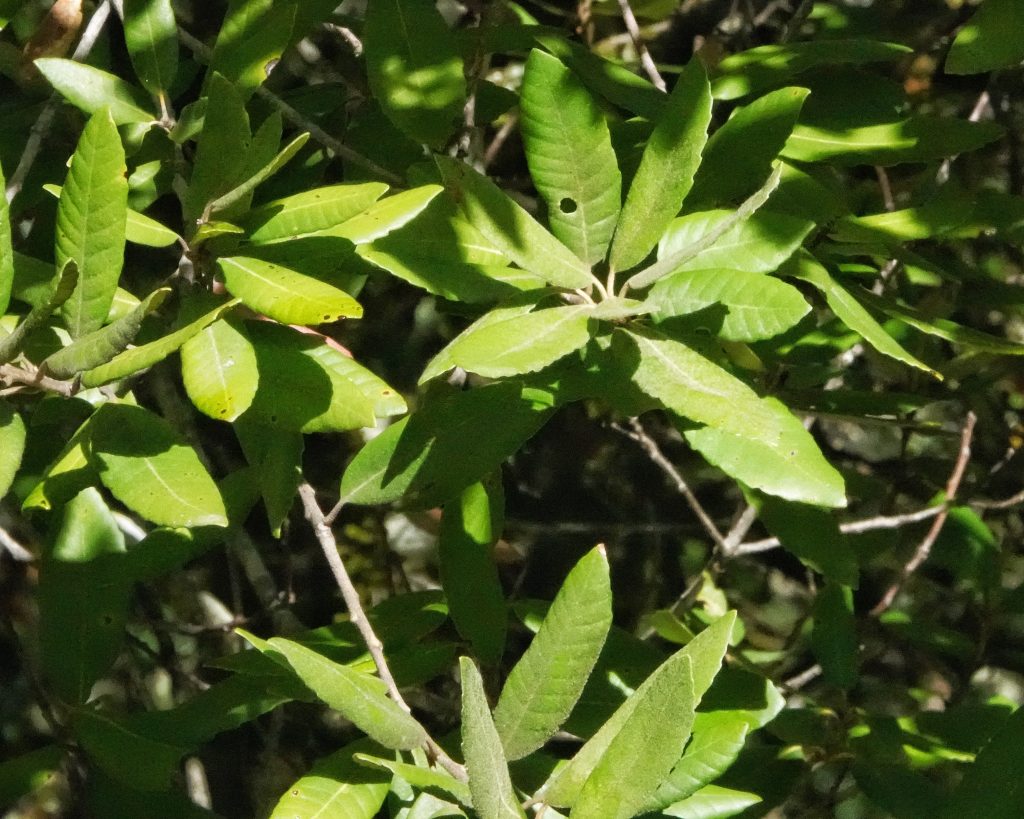
Since the mid 1990s there has been a pernicious threat looming over the forests and woodlands in sw Oregon and n California, and that threat is Sudden Oak Death (SOD). I really meant to talk about this in the Oregon Myrtle profile, because Umbellularia californica is a primary vector species. The disease is caused by the pathogen Phytophthora ramorum, a type of protist called an oomycete, which infects the leaves of the first host, and then the boles of subsequent susceptible trees and shrubs. It doesn’t usually kill the Oregon myrtles (or the rhododendrons, Doug-fir, redwoods, evergreen huckleberries, big-leaf maple, madrones, etc) that it infects, but instead causes ramorum leaf blight, which produces large leaf lesions from which massive numbers of spores are released, to be distributed by wind and rain, and these spores infect the surrounding shrubs and trees. But SOD is deadly for tanoak, and several other species of oaks, killing the leaves and causing bleeding cankers on the boles, which either kills the tree outright or makes it susceptible to infestation by the ambrosia beetle Monarthrum scutellare, and the bark beetle Pseudopityophthorus pubipennis, which combine to finish the job. This disease has killed over a million tanoak and other oaks, and it is spreading northward, with a new infestation having been found in Port Orford in April of 2021, 30 miles north of its previous northerly occurrence. For more information on SOD see the UC-Riverside Center for Invasive Species Research article here.
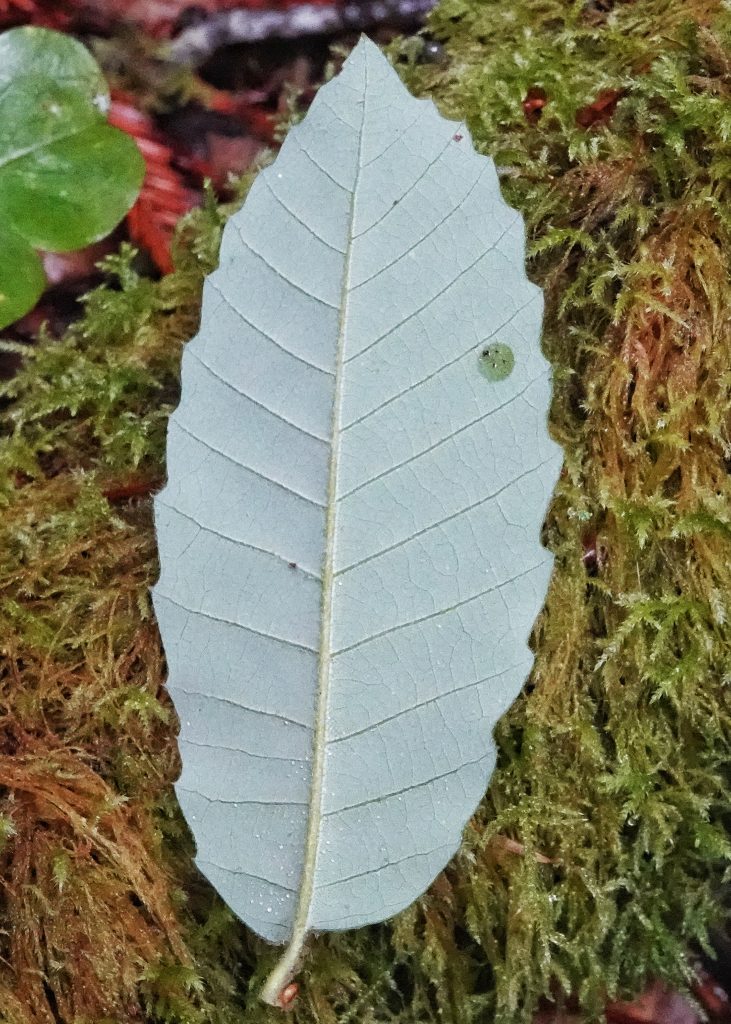
Something I don’t write about often, since it seems to me to be self evident, but which seems apropos here because of the spread of SOD, is that trees, shrubs, and plants are the foundation of all ecosystems. For one thing, the absence of a species of tree or plant doesn’t just affect the vertebrate and invertebrate species that feed upon it; it affects the organisms that feed on them, and so on up the food chain. And the value of a tree to an ecosystem is not just in the food it provides; they also provide shade, shelter, cover, substrate, nesting places, microclimates, microhabitats, and their fallen leaves and other detritus not only feed a multitude of organisms, but contribute to the chemical composition of the ground. As an example, studies in n California showed that the abundance (many of which don’t actually consume any part of the tanoak) of 12 species of birds, 7 mammals, and 5 salamanders, increased with an increase in tanoak canopy.
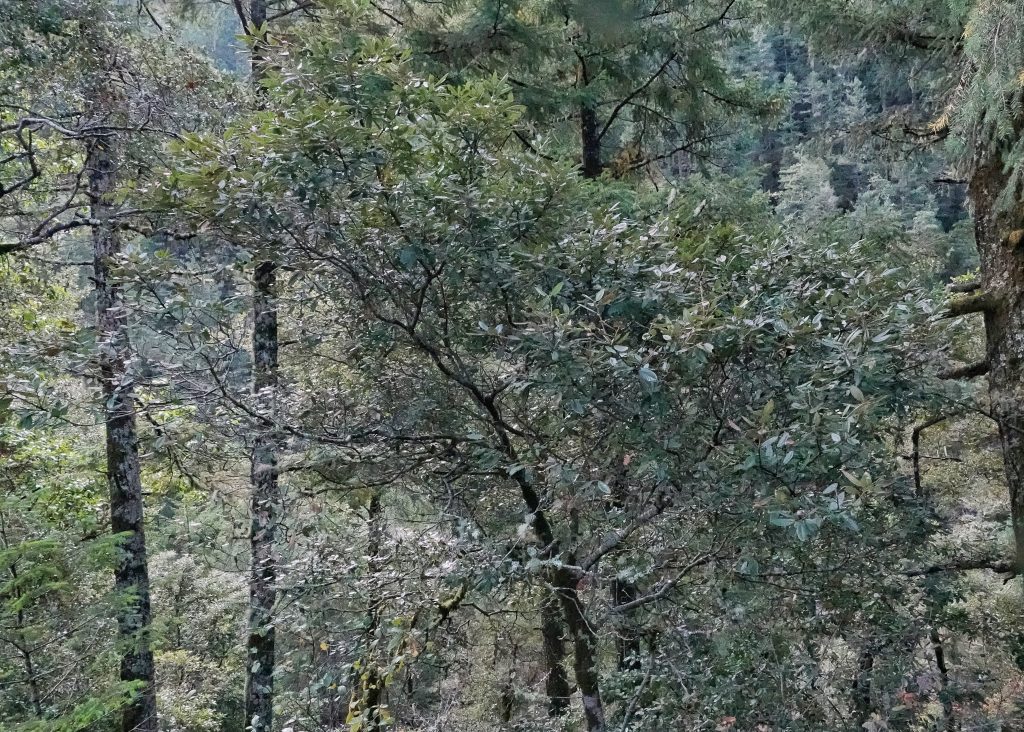
Description-Medium to large (up to 100’ tall) tree or shrub with persistent, evergreen leaves that are oval, 1-5.5” long, shiny green above, and finely haired and light green below, twigs that are yellowish and densely hairy, and greyish brown, smooth to furrowed bark; leaves curl under at the edges, are somewhat raised or wrinkled between the veins, often toothed, and most have a rounded tip; acorns are .5-1.5” long, and the cap is spiny; catkins are located in leaf axils, and are narrow, erect, and individual flowers lack petals.
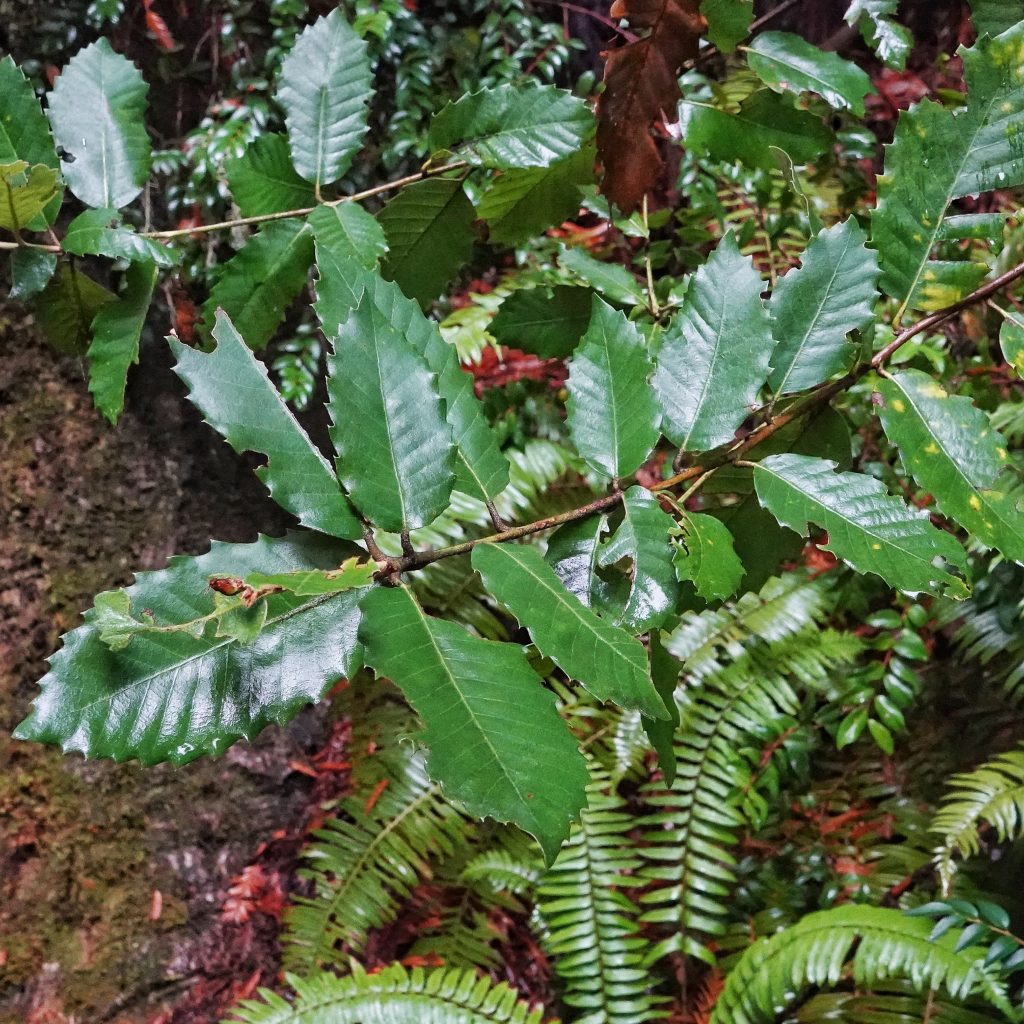
Similar species–Chrysolepis chrysophylla has narrower leaves that are not wrinkled and are scaly underneath, and spines covering the whole fruit, as they also do in Chrysolepis sempervirens; Quercus chrysolepis has smaller leaves that are hairy on both sides, and acorn cap lacks burs, as do those of all Quercus.
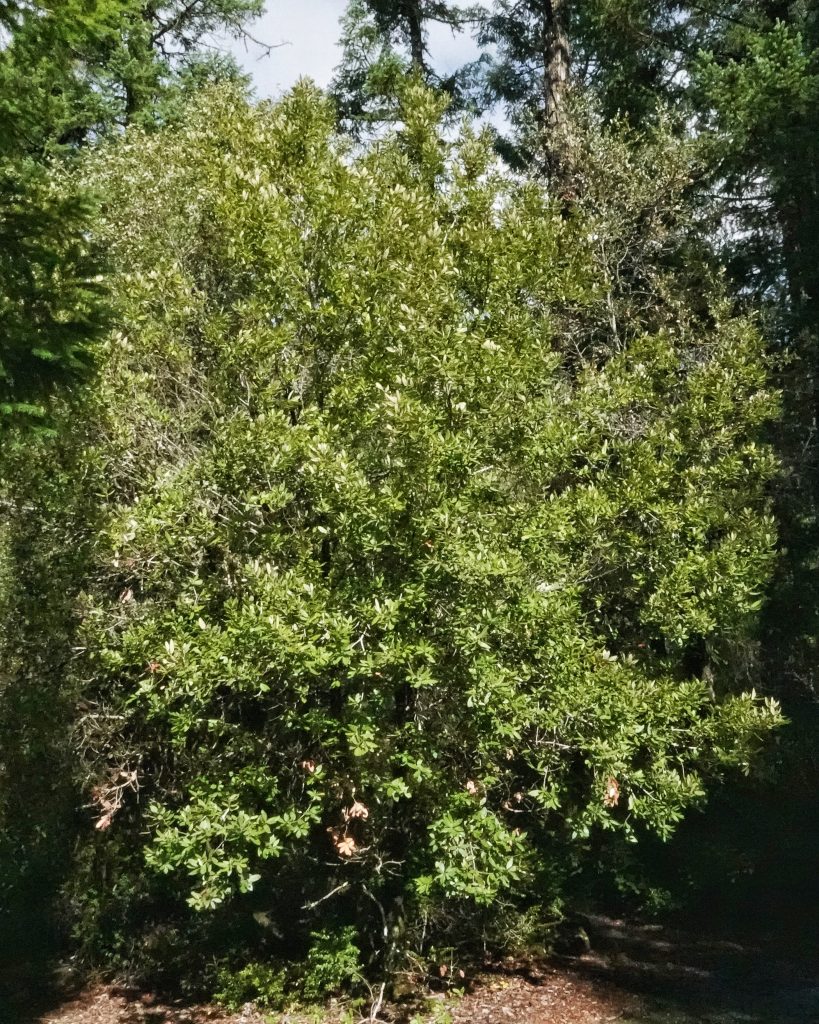
Habitat-Mixed hardwood and conifer forests up to middle elevations; in our region it is often associated with redwoods, Doug-fir, Oregon myrtle, and madrones.
Range-Sw corner of Oregon and nw California in our region, as well as the along the California coast and in disjunct populations in the n Sierras.
Reproductive timing-Blooms late spring to late summer; acorns take 2 years to develop, mature late summer into fall, and separate from the tree in fall.
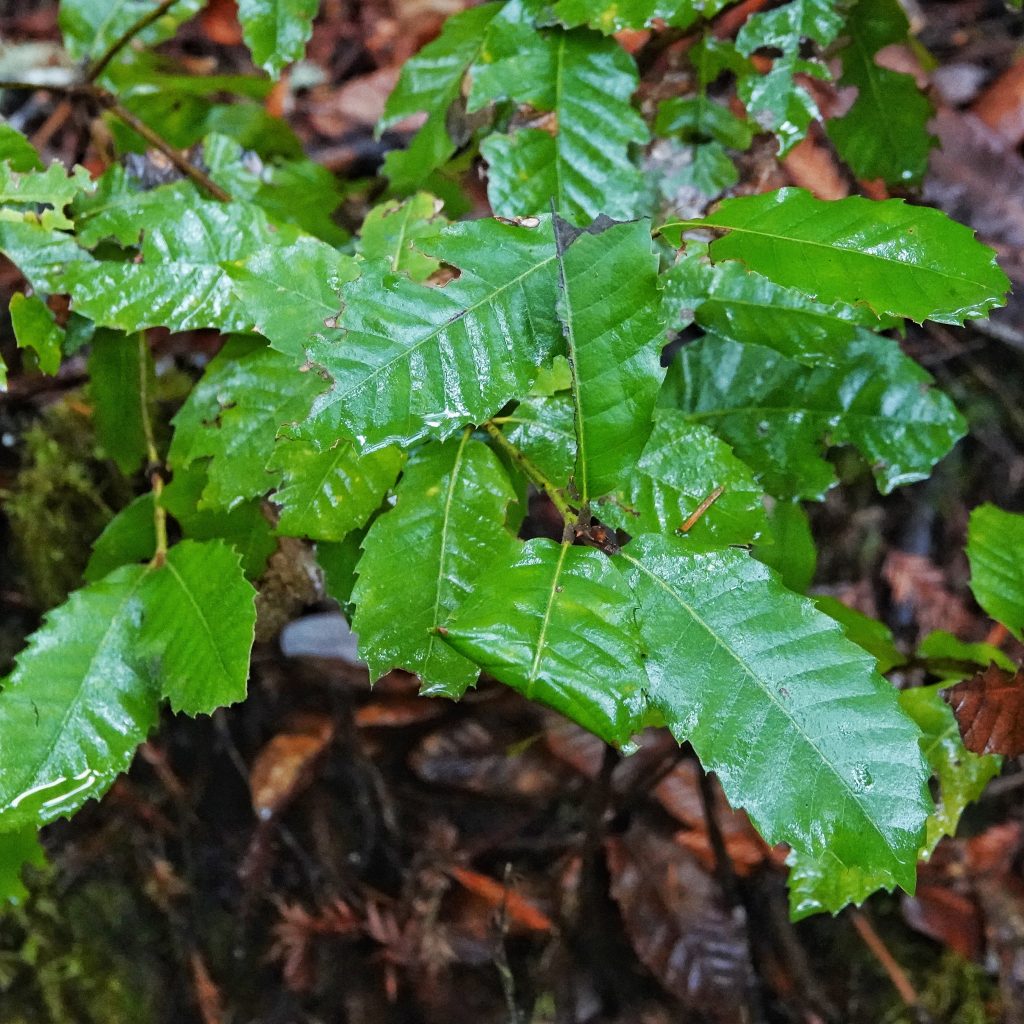
Eaten by-Larval host for the butterflies Golden Hairstreak, California Sister, Propertius Duskywing and Mournful Duskywing, and the moths Eupithecia misturata, Perigonica angulata, P. pectinata, Phryganidia californica, Telphusa sedulitella, Gracillariidae, Cameraria leucothorax, C. marinensis, Cydia latiferreana, Epinotia emarginana, E. fumoviridana, Rectiostoma fernaldella, as well as the leaf mining moth Phyllonorycter leucothorax, and some in the genera Bucculatrix, Stigmella, Marmara, Caloptilia, and Cameraria; the larvae of the weevil Curculio uniformis feed on the acorns; adults of the buprestid Agrilus angelicus girdle the twigs, and adults of the false powderpost beetle Melagus confertus bore into the base of the twigs; deer browse the seedlings, and raccoons, bears, deer, squirrels, chipmunks, wood rats and other rodents, and Steller’s jays and other corvids, acorn woodpeckers, varied thrush, and other birds all consume the acorns; the longhorn beetles Callimoxys fuscipennis, Encyclops californicus, Grammoptera rhodopus, G. subargentata, Hybodera debilis, Lophopogonius crinitus, Necydalis cavipennis, N. laevicollis, Ortholeptura insignis, Phymatodes aeneus, P. grandis, P. infuscatus, P. obliquus, Pidonia scripta, Xestoleptura crassipes, and Xylotrechus nauticus utilize dying and dead trees as larval hosts.
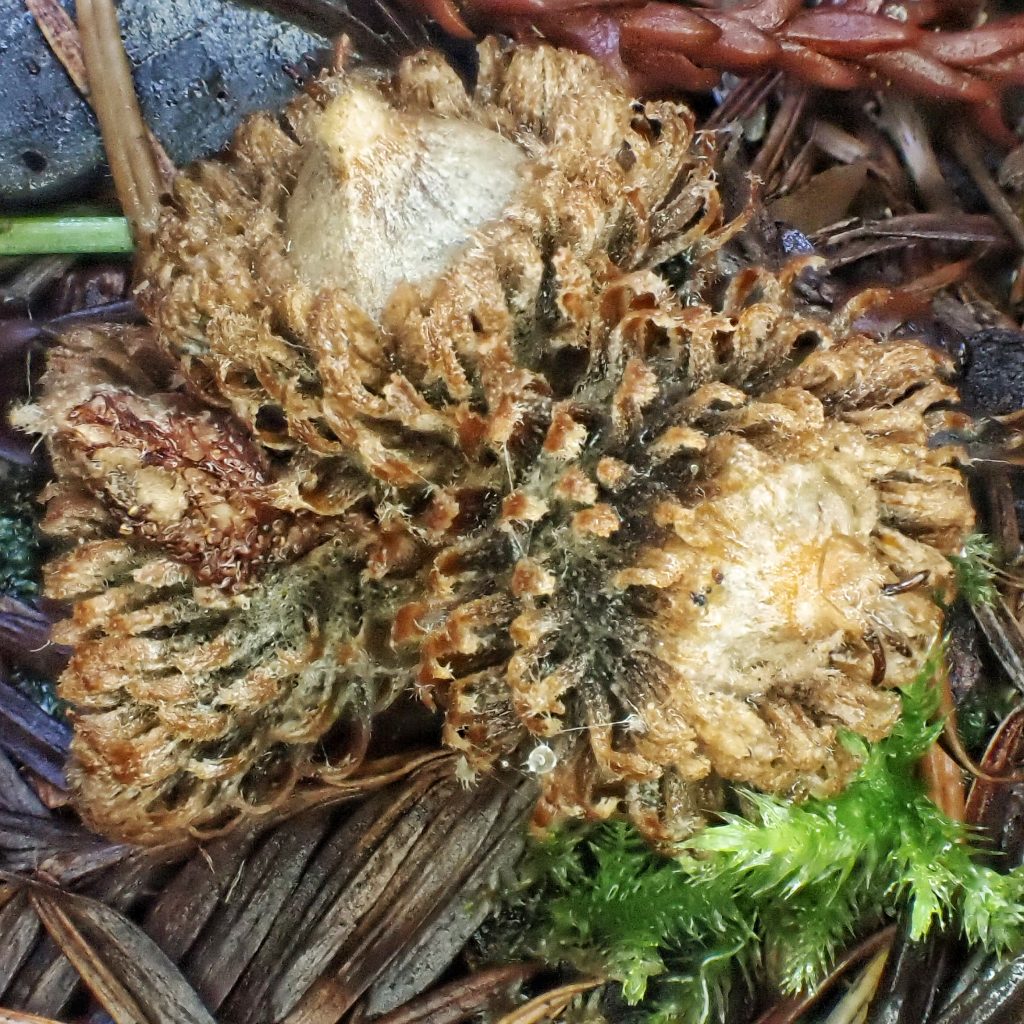
Etymology of names–Notholithocarpus is from the Greek words for ‘spurious/illegitimate’ and ‘stone fruit’, referring to the fact that this tree was formerly in the genus Lithocarpus, which referred to the hard wall of the acorn, but was found to not be closely related to this Asian genus. The specific epithet densiflorus is from the Latin words for ‘thick with flowers’, presumably referring to the density of the flowers on the catkins.
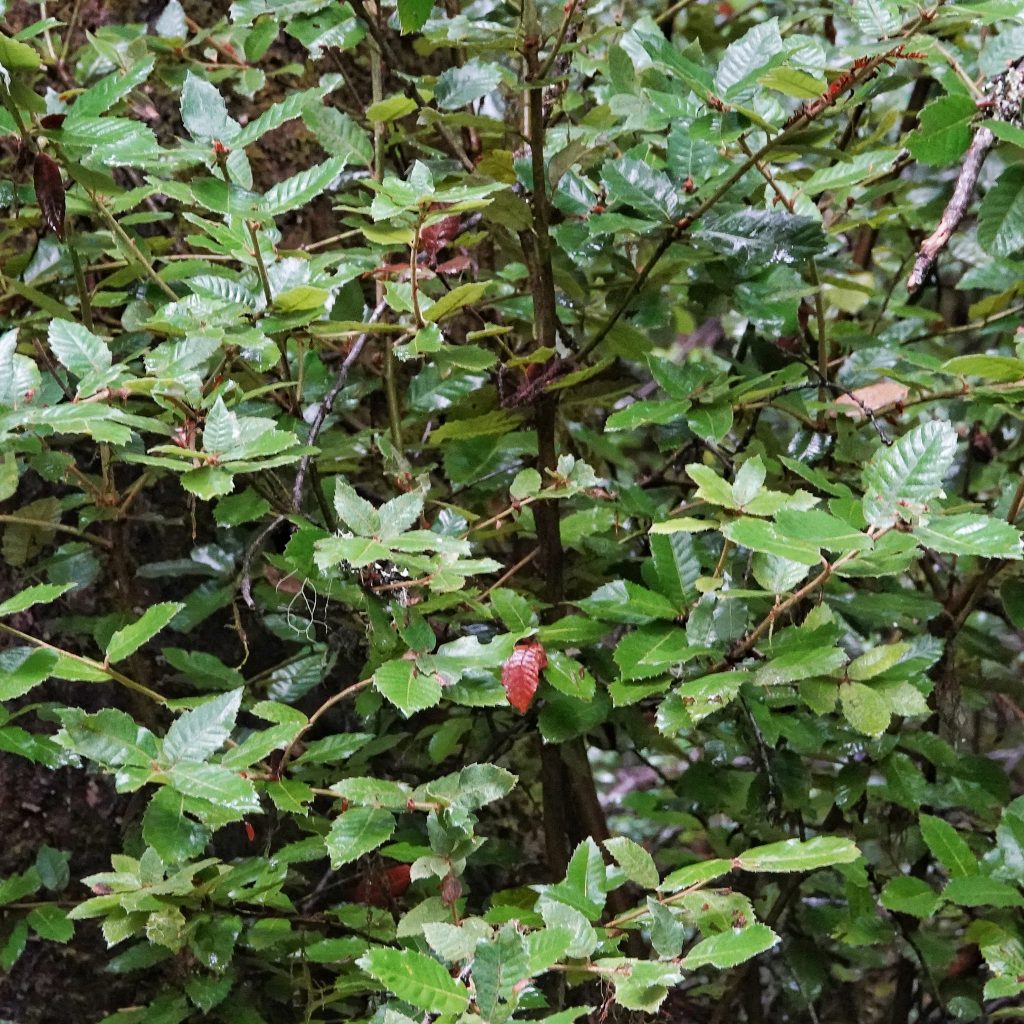
https://www.srs.fs.usda.gov/pubs/misc/ag_654/volume_2/lithocarpus/densiflorus.htm
https://www.fs.usda.gov/database/feis/plants/tree/notden/all.html
https://owic.oregonstate.edu/tanoak-lithocarpus-densiflorus
https://landscapeplants.oregonstate.edu/plants/notholithocarpus-densiflorus
BRIT – Native American Ethnobotany Database
https://www.wildcalifornia.org/post/the-bounty-of-tanoaks
https://ucanr.edu/sites/Marin2013Report/files/186105.pdf
https://cisr.ucr.edu/invasive-species/sudden-oak-death
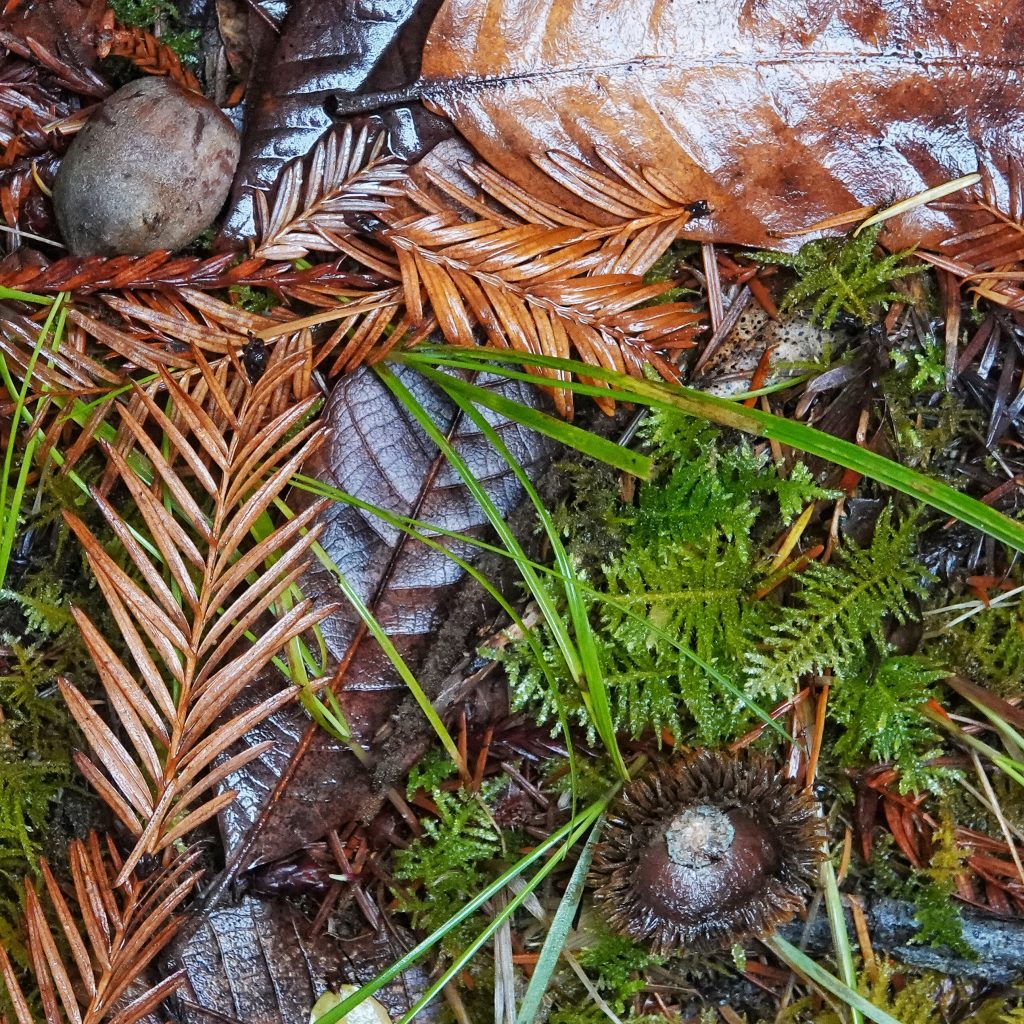
This is a good and important essay on the Tan Oak, and the importance of trees generally. Thank you.
Thanks for your appreciation, Michael. The depth of how bad that SOD can be really shocked me.
The first time I saw those leaves I was intrigued, too – and it was in a Redwood forest in northern CA. Thanks for the information about the tree, about SOD, and the note about the value of trees to all ecosystems. The forest floor still life is beautiful, too.
Thank you Lynn, for your appreciation! I saw a sign about SOD at Loeb SP, but didn’t realize how bad it was/could be until I started researching tanoak and Myrtle when I got home. Kinda scary!
Thanks again Dan and pointedly for your fine photography and image quality always.
Thanks for your appreciation, Brooke! Can’t take a lot of credit for the photos, because I’m not really a photographer. All credit goes to the camera when they turn out well, although all blame falls on me when they don’t 😀
One of my absolute favorite trees from the region. I particularly favor the shrubbier forms, var. echinoides that have a silvery-blue cast to the leaves.
Sadly, another example of the devastation brought about by unfettered international trade in plants. We have been accidentally bringing in invasive pathogens and insects for well over 100 years. The scale of environmental damage is beyond what most of us even know about. White pine blister rust, Dutch elm disease, Chestnut blight, dogwood anthracnose, emerald ash borer, spongy moth, … Ramorum blight is only one of the latest examples. It’s scary to see the extent of damage.
Yes, it can all make me very sad. Probably going to be a vastly different composition of our flora and fauna in another 100 years.